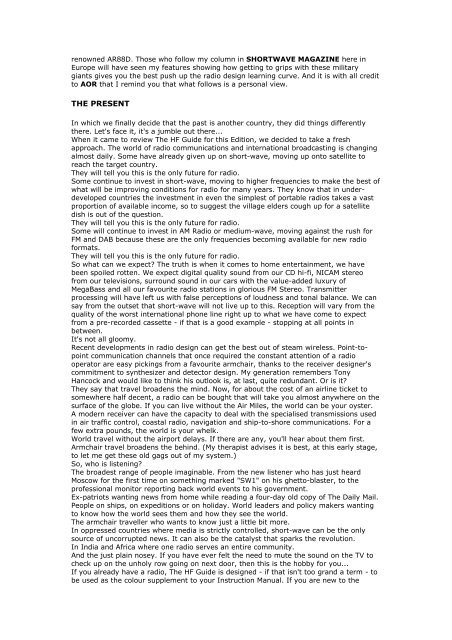Listener's Guide - 1999 - The Listeners Guide
Listener's Guide - 1999 - The Listeners Guide
Listener's Guide - 1999 - The Listeners Guide
Create successful ePaper yourself
Turn your PDF publications into a flip-book with our unique Google optimized e-Paper software.
enowned AR88D. Those who follow my column in SHORTWAVE MAGAZINE here inEurope will have seen my features showing how getting to grips with these militarygiants gives you the best push up the radio design learning curve. And it is with all creditto AOR that I remind you that what follows is a personal view.THE PRESENTIn which we finally decide that the past is another country, they did things differentlythere. Let's face it, it's a jumble out there...When it came to review <strong>The</strong> HF <strong>Guide</strong> for this Edition, we decided to take a freshapproach. <strong>The</strong> world of radio communications and international broadcasting is changingalmost daily. Some have already given up on short-wave, moving up onto satellite toreach the target country.<strong>The</strong>y will tell you this is the only future for radio.Some continue to invest in short-wave, moving to higher frequencies to make the best ofwhat will be improving conditions for radio for many years. <strong>The</strong>y know that in underdevelopedcountries the investment in even the simplest of portable radios takes a vastproportion of available income, so to suggest the village elders cough up for a satellitedish is out of the question.<strong>The</strong>y will tell you this is the only future for radio.Some will continue to invest in AM Radio or medium-wave, moving against the rush forFM and DAB because these are the only frequencies becoming available for new radioformats.<strong>The</strong>y will tell you this is the only future for radio.So what can we expect? <strong>The</strong> truth is when it comes to home entertainment, we havebeen spoiled rotten. We expect digital quality sound from our CD hi-fi, NICAM stereofrom our televisions, surround sound in our cars with the value-added luxury ofMegaBass and all our favourite radio stations in glorious FM Stereo. Transmitterprocessing will have left us with false perceptions of loudness and tonal balance. We cansay from the outset that short-wave will not live up to this. Reception will vary from thequality of the worst international phone line right up to what we have come to expectfrom a pre-recorded cassette - if that is a good example - stopping at all points inbetween.It's not all gloomy.Recent developments in radio design can get the best out of steam wireless. Point-topointcommunication channels that once required the constant attention of a radiooperator are easy pickings from a favourite armchair, thanks to the receiver designer'scommitment to synthesizer and detector design. My generation remembers TonyHancock and would like to think his outlook is, at last, quite redundant. Or is it?<strong>The</strong>y say that travel broadens the mind. Now, for about the cost of an airline ticket tosomewhere half decent, a radio can be bought that will take you almost anywhere on thesurface of the globe. If you can live without the Air Miles, the world can be your oyster.A modern receiver can have the capacity to deal with the specialised transmissions usedin air traffic control, coastal radio, navigation and ship-to-shore communications. For afew extra pounds, the world is your whelk.World travel without the airport delays. If there are any, you'll hear about them first.Armchair travel broadens the behind. (My therapist advises it is best, at this early stage,to let me get these old gags out of my system.)So, who is listening?<strong>The</strong> broadest range of people imaginable. From the new listener who has just heardMoscow for the first time on something marked "SW1" on his ghetto-blaster, to theprofessional monitor reporting back world events to his government.Ex-patriots wanting news from home while reading a four-day old copy of <strong>The</strong> Daily Mail.People on ships, on expeditions or on holiday. World leaders and policy makers wantingto know how the world sees them and how they see the world.<strong>The</strong> armchair traveller who wants to know just a little bit more.In oppressed countries where media is strictly controlled, short-wave can be the onlysource of uncorrupted news. It can also be the catalyst that sparks the revolution.In India and Africa where one radio serves an entire community.And the just plain nosey. If you have ever felt the need to mute the sound on the TV tocheck up on the unholy row going on next door, then this is the hobby for you...If you already have a radio, <strong>The</strong> HF <strong>Guide</strong> is designed - if that isn't too grand a term - tobe used as the colour supplement to your Instruction Manual. If you are new to the

















